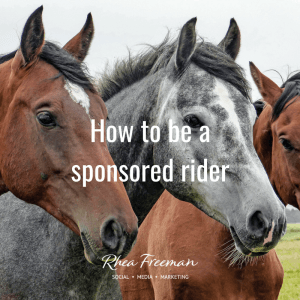
In this week’s podcast I speak to Pippa Hawksfield and Jess Crofts from Stride Management. This business was set up by two best friends to address the issue of rider management, sponsored riders, and how brands can work with both more effectively. This is a subject I’m really passionate about. I work with a number of brands and many of these work with riders. I’ve seen amazing relationships with riders that have really blossomed into exciting things. And I’ve seen ones that have generated nothing. But that’s enough from me, over to the ladies at Stride Management to share their tips and thoughts. It’s a good one.
Sponsored riders, managing riders, and how it can help equestrian businesses
Here are the show notes from the Small & Supercharged Podcast- Episode 19, all about sponsored riders, managing riders and how this can help equestrian businesses. We also have a delve into Stride Management and how the business works, the support it offers, and why it started life.
- How the idea for Stride Management developed from conversations with brands saying they really struggled with riders, and seeing how some riders go above and beyond.
- Why some riders don’t approach brands, even if they could do a really good job for them.
- The disconnect between some riders who are very skilled at what they do (and very nice people too!), and delivering to brands who they want support from.
- How some brands expect riders to do things for them with no information. As all brands are different, we speak about the value of two way communication.
- The importance of coming up with ideas for brands.
- Why it’s important for riders to speak to brands they really do like, not just from the brand’s point of view, but also from the rider’s personal brand point of view too.
- We talk about good approaches and not so good ones… and the difference between the two.
- What Stride Management do day to day for the riders they manage.
- How brands can also work with rider management companies to get the most out of them too.
- The difference between supporting the riders and brands, and being the gatekeeper.
- How working with management companies can be good for riders, to help them serve current sponsors better, get new sponsors, and ease the workload too.
- The importance of really good, strong imagery and how that’s something to consider.
- For riders – we talk about top tips, such as what to do if a rider likes a brand and how that ‘journey’ should progress, and why riders shouldn’t give up too easily – a no might not be a no forever, it might just be a no for now. We run through a good few additional top tips too.
- For brands – we talk about when you’re looking at riders, thinking about the support team around them and how they’re going to deliver on what they promise to you. We talk about engagement as well as following on social media, and a few other top tips too.
- We discuss the value of people with engaged followings on social media, rather than riders who compete at the top of their game.
- And we talk about brand ambassadors, sponsored riders, financial gain and products being gifted too.
To find out more about Stride Management, find them here…
And for a little further reading…
If you fancy a little further reading about this subject, I have written a few blogs around the subject here…

